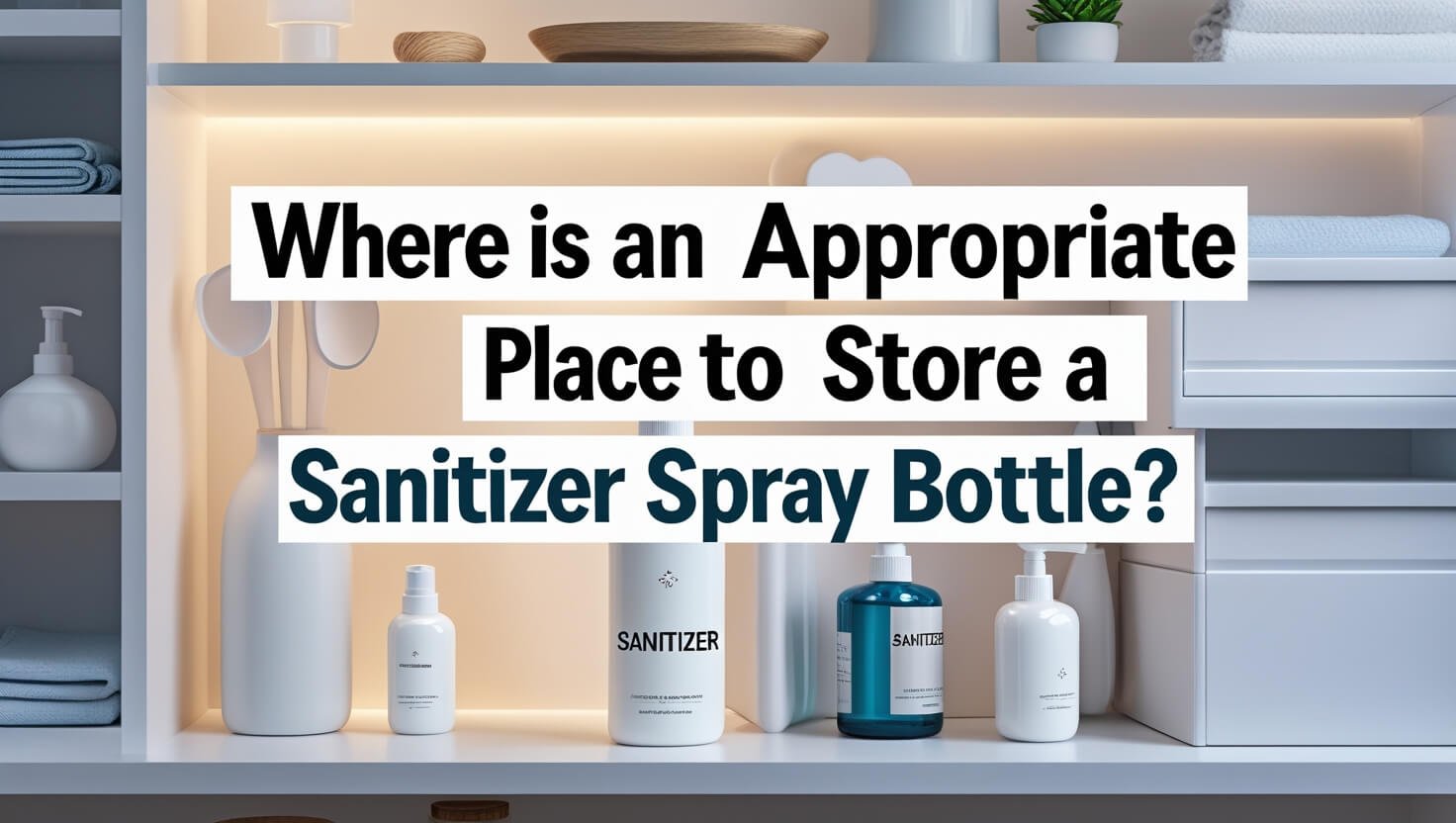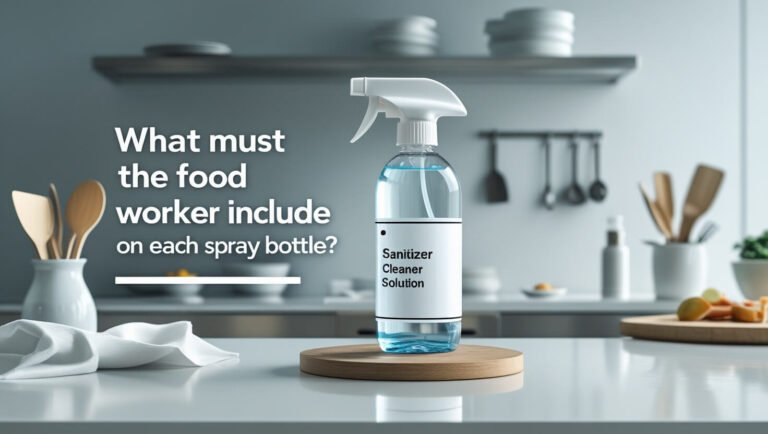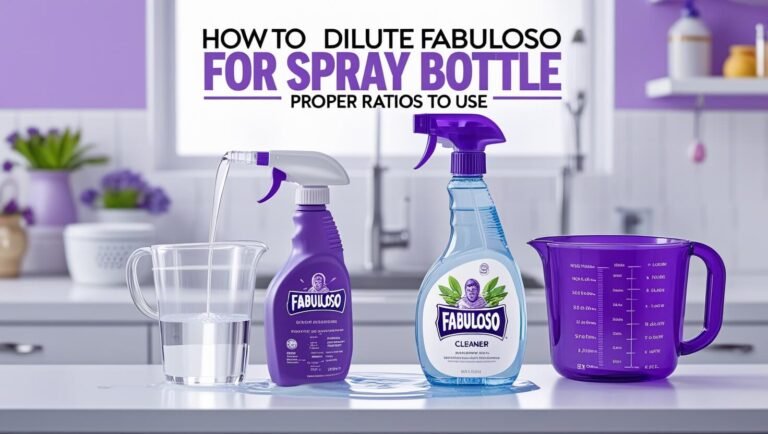Where Is An Appropriate Place To Store A Sanitizer Spray Bottle?

Storing sanitizer spray bottles correctly is key to keep things clean and safe. The FDA says cleaning supplies should be kept away from food and food items. So, where should you put a sanitizer spray bottle to keep everything safe?
Putting spray bottles in the wrong place can cause spills and harm. The FDA and OSHA have rules for labeling and storing cleaning supplies. By picking the right spot for your sanitizer bottle, you help keep food and workers safe. Let’s look at why proper storage is important and where to keep your sanitizer spray bottles.
Safety Requirements for Sanitizer Storage
Storing hand sanitizer safely is key to keeping it effective and safe. It’s important to store it where children can’t reach it to avoid accidents. This helps keep the sanitizer quality high.
The Nevada Division of Public and Behavioral Health says it’s vital to follow the maker’s storage and use tips. Keep the sanitizer in a cool, dry spot, away from sunlight and heat. Also, don’t store it where it can get hotter than 105°F.
Temperature Control Guidelines
Keeping the sanitizer at the right temperature is very important. Don’t store it in a hot car during summer. High temperatures can make the sanitizer less effective and unsafe.
Ventilation Requirements
Good air flow is also key when storing hand sanitizer. Make sure the area is well-ventilated to avoid fume buildup and fire risks. Also, keep it away from any open flames or sparks.
Fire Safety Considerations
Fire safety is another big deal when storing hand sanitizer. Use a fire-resistant container and keep it away from things that can catch fire. By following these tips, you can ensure the sanitizer is safe and works well.
| Storage Considerations | Recommendations |
|---|---|
| Temperature | Below 105°F |
| Ventilation | Well-ventilated area |
| Fire Safety | Fire-resistant container, away from combustible materials |
Ideal Room Placement for Sanitizer Bottles
Choosing the right spot for sanitizer bottles is key. It should be easy to get to but safe from contamination. Food safety rules say to keep sanitizers in a utility closet or a special area. This keeps them away from food and surfaces that touch it.
Think about a few things when picking a spot for hand sanitizer. It should be close to food but not too close. It needs good air flow and should be easy to get to. A cool, dry spot away from sunlight is best for keeping the sanitizer working well. Make sure spray bottles are out of kids’ and pets’ reach to avoid accidents.
Here are some important things to consider for the best sanitizer storage area:
- Store sanitizer bottles in a well-ventilated area to prevent the buildup of fumes
- Keep them away from heat sources, such as ovens or stovetops
- Ensure the storage area is easily accessible for frequent use
- Label the storage area clearly to prevent misidentification
By picking the right spot for your sanitizers, you can keep things clean and safe. Always follow the maker’s storage and use tips. Also, test the sanitizer with test strips often to keep it strong enough for food surfaces.
| Sanitizer Type | Concentration Range | Effective Temperature Range |
|---|---|---|
| Chlorine (Bleach) | 50-100 PPM | Up to 100°F |
| Quaternary Ammonia (QUAT) | 0-500 PPM | Stable at high temperatures up to 100°F |
| Iodine | 12.5-25 PPM | Not specified |
Cabinet Storage Solutions
Choosing the right spot for sanitizer bottles is key. Cabinet storage is a great way to keep them organized and safe. Think about space, how easy it is to get to them, and keeping them secure.
Here are some top picks for storing sanitizer:
- Upper cabinet placement: perfect for less used sanitizers, keeps them safe from kids and tidy.
- Lower cabinet placement: great for often-used sanitizers, makes them easy to grab.
- Child-proof storage options: a must for places with kids, keeps sanitizers safe and sound.
- Commercial storage systems: ideal for big places, offers neat and efficient storage.
When picking a spot for hand sanitizer, think about the cabinet type and where it is. The right cabinet keeps your sanitizer bottles safe and your space tidy. Always label and store them right, as shown in “What Must The Food Worker Include On Each Spray Bottle,” for their best use and safety.
| Storage Option | Benefits | Considerations |
|---|---|---|
| Upper Cabinet Placement | Keeps sanitizers out of reach of children, minimizes clutter | Less accessible, may require ladder or step-stool |
| Lower Cabinet Placement | Provides easy access, convenient for frequent use | May be more accessible to children, requires child-proofing |
| Child-Proof Storage Options | Ensures sanitizers are stored safely and securely | May be more expensive, requires installation |
| Commercial Storage Systems | Provides efficient and organized sanitizer storage | May be more costly, requires significant space |
Where Is an Appropriate Place to Store a Sanitizer Spray Bottle
Storing sanitizer spray bottles right is key for safety and effectiveness. The Nevada Division of Public and Behavioral Health says to keep them in a cool, dry spot. Make sure they’re away from sunlight and heat.
Where you put the sanitizer bottle matters a lot. It helps avoid accidents and keeps things safe. Here are some important things to think about:
- Put them in a place with good air flow to stop fumes from building up
- Keep them where kids and pets can’t get to, to stop them from drinking it or playing with it
- Make sure they’re labeled well so you don’t mix them up with other cleaners
Choosing the right spot for your sanitizer spray bottles and following the right storage tips helps a lot. Always check the label for special storage tips. And remember, a cool, dry place, away from sunlight and heat, is the best spot for them.
| Storage Considerations | Recommendations |
|---|---|
| Temperature | Away from heat sources and direct sunlight |
| Ventilation | Well-ventilated area to prevent fume accumulation |
| Labeling | Clear labeling to prevent mix-ups with other products |
Storage Areas to Avoid
When picking a spot for hand sanitizer, think about where it should not be. It’s key to keep it safe from accidents and ensure it works well. Look for places that could harm the sanitizer or those around it.
Don’t store sanitizer near food or where it might touch food. The Empower Employees Through Food Safety Training says to stay away from risky spots. This means places where chemicals or cleaning supplies are used, as they can mess with the sanitizer.
High-Risk Locations
Places near heat, like ovens or radiators, and humid spots are bad for sanitizer. Also, keep it away from kids to avoid accidents.
Temperature Danger Zones
Areas near boilers or furnaces can also harm the sanitizer. Store it in a cool, dry place to make it last longer. By avoiding these spots, you keep your sanitizer safe and effective, helping keep your space clean and healthy.
Proper storage is key to keeping sanitizer working. Choose a safe spot, like a closet or cabinet, to avoid contamination. Always follow the right storage tips to get the best from your hand sanitizer.
Professional Storage Standards
Storing sanitizer bottles right is key to keeping them safe and effective. Proper sanitizer storage stops contamination and keeps quality high. Choose a ideal sanitizer storage area that’s cool, dry, and well-ventilated.
For sanitizer bottle placement, follow OSHA’s rules. Label bottles well, store them safely, and keep them away from kids and pets. This way, your sanitizer bottles stay a vital part of keeping things clean and healthy.
Some important points for proper sanitizer storage are:
- Store bottles in a well-ventilated spot to avoid fume buildup.
- Keep bottles away from heat sources like radiators or heaters.
- Store bottles in a secure place, like a locked cabinet or high shelf.
Considering sanitizer bottle placement and storage keeps them safe and effective, ensuring cleanliness and health.
Storage Solutions for Different Bottle Sizes
The size of the sanitizer bottle is key when it comes to storage. Each size needs its own solution for safety and ease. The right spot for a sanitizer bottle depends on its size, type, and where you have space.
Small bottles need a neat storage spot. You can use baskets, bins, or shelves to keep them tidy. Think about how often you use it and how easy it should be to get to. For example, a small bottle might go in a desk drawer or on a bathroom counter.
Small Bottle Organization
Small bottles can be stored in many ways, including:
- Desk drawers or organizers
- Bathroom counters or shelves
- Wall-mounted dispensers
These options help keep small bottles organized and handy.
Bulk Storage Methods
For bigger bottles or lots of sanitizer, consider:
- Shelving units or storage racks
- Large bins or containers
- Sanitizer storage cabinets
These solutions keep bulk supplies organized and safe. They also make it easy to access when you need it.
Choosing the right storage for your sanitizer bottles is important. Think about the bottle size, type, and where you have space. This ensures your storage is safe and efficient.
| Bottle Size | Storage Solution |
|---|---|
| Small (8 oz) | Desk drawer or bathroom counter |
| Medium (16 oz) | Shelving unit or storage rack |
| Large (1 gallon) | Sanitizer storage cabinet or large bin |
Protection from Environmental Factors
When choosing where to store hand sanitizer, think about the environment. The best place is away from sunlight and moisture. This keeps the active ingredients from breaking down. Keeping hand sanitizer in good condition is key to its safety and effectiveness.
Sunlight and humidity can harm hand sanitizers. Sunlight exposure can make the alcohol evaporate, reducing its power. Humidity can also cause bacteria and mold to grow, making the sanitizer unsafe. To avoid these problems, store hand sanitizers in a cool, dry spot, away from sunlight and moisture.
To keep hand sanitizers safe from the environment, follow these tips:
- Store hand sanitizers in a well-ventilated area to prevent moisture buildup.
- Keep hand sanitizers away from direct sunlight, such as near a window or in a car.
- Use a storage container that is airtight and moisture-proof to prevent contamination.
By following these tips, your hand sanitizers will stay effective and safe. Always check the label for storage instructions and use hand sanitizers as directed.
Multi-Room Storage Strategies
Storing sanitizer bottles in a multi-room setting requires careful planning. You need to find the best place for each room. This spot should be easy to reach and safe for the bottles.
In places like hotels or offices, a good storage plan is key. You should pick a spot for cleaning supplies, like a janitor’s closet. Use labels and signs to show where the sanitizer is.
Here are some tips for a good storage plan:
- Choose a central spot for all cleaning supplies, including sanitizer bottles.
- Use labels and signs to show where sanitizer bottles are in each room.
- Make sure all staff know where to find and use the sanitizer bottles.
With a good storage plan, you can keep your space clean and healthy. You’ll also make sure sanitizer bottles are in the right place and easy to get to.
The Bottom Lines
Storing sanitizer spray bottles right is key to keeping them working well and safe. By storing them in a cool, dry spot, away from sunlight, you keep them strong. This makes sure your sanitizer is always ready to use.
It’s also important to label sanitizer bottles clearly and give safe use instructions. This helps avoid misuse and promotes safe storage and use at home or work. Storing your sanitizer bottles well is a big step in keeping your space clean and everyone safe.
Short Questions:
What are the safety requirements for storing sanitizer bottles?
Storing sanitizer bottles safely involves controlling temperature, ensuring good ventilation, and fire safety. Always follow the manufacturer’s instructions. Make sure the storage area meets these standards.
What is the ideal room placement for sanitizer bottles?
The best spot for sanitizer bottles is near but not too close to food. It should also have good ventilation and be easy to reach. This helps keep the area clean and safe.
What are the best cabinet storage solutions for sanitizer bottles?
For storing sanitizer bottles, consider where to place them in cabinets. Look at options like child-proof storage and commercial systems. The right choice depends on your space and needs.
Where is an appropriate place to store a sanitizer spray bottle?
Sanitizer spray bottles should be kept in a cool, dry spot. Avoid direct sunlight and heat. The storage area should also control temperature and humidity to keep the sanitizer effective and safe.
What storage areas should be avoided when storing sanitizer bottles?
Stay away from high-risk and temperature danger zones when storing sanitizer bottles. These areas can harm the sanitizer’s effectiveness and safety. It’s key to identify and avoid these hazards.
What are the professional storage standards for sanitizer bottles?
Professional standards for storing sanitizer bottles include proper labeling and handling. Following these guidelines ensures the bottles meet safety and regulatory needs.
What storage solutions are available for different sanitizer bottle sizes?
For various bottle sizes, consider small bottle organizers and bulk storage. The best option depends on your space, accessibility, and security needs.
How can sanitizer bottles be protected from environmental factors?
To shield sanitizer bottles from sunlight and humidity, use prevention and control methods. This keeps the sanitizer effective and safe to use.
What are some multi-room storage strategies for sanitizer bottles?
For storing sanitizer bottles across multiple rooms, focus on accessibility, security, and clear labeling. This ensures the bottles are both accessible and secure in different areas.




